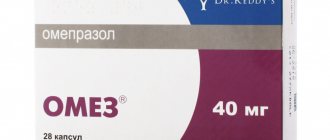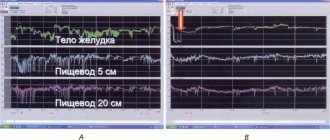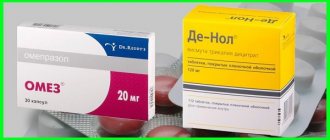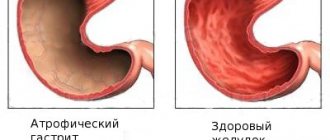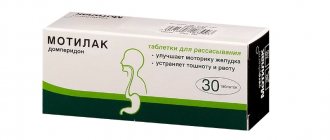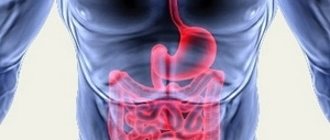To reduce the production of hydrochloric acid by the stomach glands, the drug omez is used. With its use, it is possible to achieve a rapid positive effect in the treatment of gastritis, gastric or duodenal ulcers, as well as many other pathologies.
Omez and omeprazole are identical medications with the same active ingredient. They have the same indications and, if contraindications are violated, cause similar adverse reactions in the body. The main difference between the drugs is different auxiliary ingredients.
The active ingredient in the drug Omez is omeprazole. The drug is produced in two forms: capsules and powder. When they say “omez tablets,” they mean transparent capsules filled with white granules. The coating may be coated with hypromellose, enteric coating, or gelatin.
A medicinal solution for internal consumption is prepared using Omez Insta powder. An additional ingredient in it is anhydrous sodium carbonate. A solution for infusion is prepared from lyophilized powder in bottles.
Effects when taken
The capsules are swallowed with water. After taking the drug, the active substance omesaprozole is quickly absorbed into the blood after entering the stomach. The maximum amount of it in the blood is detected after about an hour. With one-time use, bioavailability is up to 40%; with continuous use, the figure increases to 60%.
It is important to understand why omez is prescribed in order to eliminate negative consequences from its improper use. The active agent, entering the body, provides rapid inhibition of the secretion of hydrochloric acid. At the same time, omez medicine, the instructions indicate this, begins to work most effectively after 4 days.
In addition, the drug omez has bactericidal properties, which makes it possible to successfully combat Helicobacter pylori bacteria. These harmful microorganisms provoke the development of gastritis and increase the risk of developing peptic ulcers. In the complex treatment of pathologies of the digestive organ in combination with antibacterial drugs omez, the instructions focus on this, allowing you to quickly eliminate unpleasant symptoms. In addition, when taking the drug, healing of the mucous membrane and long-term remission of peptic ulcer disease are guaranteed, which reduces the likelihood of complications such as bleeding.
Other effects associated with decreased hydrochloric acid production:
- With long-term use of the drug, the formation of benign glandular cysts in the stomach is possible, which resolve over time.
- The likelihood of intestinal infections, which can be caused by various harmful bacteria, increases.
Omeprazole does not help with heartburn, how to get rid of it?
Author: Kulikova Yulia Rinatovna
Omeprazole is an antisecretory drug of the first generation of proton pump inhibitors, which has been used since 1979 and is one of the most commonly prescribed drugs for patients with heartburn and hyperacidity of the stomach. It has a long-lasting inhibitory effect on gastric secretion and blocks the process of producing hydrochloric acid in the stomach, and therefore should relieve discomfort.
And if omeprazole does not help you or has stopped helping, it is necessary: “to understand the reasons,” as the chief physician of the Gastroenterological Center, Sabir Nasredinovich Mehdiev, says.
Causes of heartburn?
Heartburn is a burning pain that appears behind the breastbone and/or in the epigastric region, spreading up to the throat as a result of the reflux of aggressive gastric contents into the esophagus (gastroesophageal reflux).
Heartburn most often occurs on an empty stomach or after a heavy meal: sweets, spicy, fatty or spicy foods. Reflux and its consequence heartburn are provoked by lard, dark chocolate, strong coffee, tomatoes, citrus fruits, especially in combination with smoking and alcohol. Being overweight or obese interferes with the functioning of the esophagus and stomach and can also cause heartburn.
If the feeling of heartburn or eaten food in the mouth occurs in a horizontal position, during physical work, including those associated with lifting heavy objects, bending the body down, additional examination is necessary. Since these symptoms may be manifestations of muscle failure (sphincter) - the locking mechanism between the esophagus and stomach . To fully examine the area of the esophagogastric junction, it is necessary to first perform fibrogastroduodenoscopy (FGDS) . Based on the results of FGDS and your condition, the gastroenterologist will prescribe the necessary treatment.
In our center you have the opportunity to perform an FGDS and get a consultation with a gastroenterologist in one visit. Pre-registration is required by calling 426-33-88 or using the form on the website.
Several reasons why heartburn, despite the use of omeprazole, does not go away
1. It is very important to be able to distinguish heartburn from chest pain (“anginal pain”) , for which omeprazole, esomeprazole, rabeprazole and other drugs do not help. This complex issue should be resolved at your appointment by your attending physician, if necessary, using ECG data and daily monitoring.
Our center sees a cardiologist, candidate of medical sciences, associate professor of the department of hospital therapy of St. Petersburg State Medical University named after. Academician I.P. Pavlova Mehtieva Olga Aleksandrovna, you can make an appointment by calling 426-33-88 or using the form on the website.
2. Persistent (difficult to treat) heartburn can be a manifestation of gastric and duodenal ulcers, and even stomach cancer . Often the “faithful companion” of these diseases is Helicobacter pylori infection, which in most cases leads to their exacerbation. Treatment in each case is individual and is carried out based on the results of an endoscopic examination of the esophagus, stomach, duodenum, as well as a 13C-urease breath test to detect Helicobacter pylori infection.
3. In addition, heartburn that cannot be treated can be a manifestation of bile reflux (reflux) . In this case, bile entering the stomach is the main cause of all symptoms. In this situation, taking omeprazole can only worsen the patient's condition. The cause of biliary (bile) reflux is often congenital anomalies in the structure of the gallbladder, leading to disruption of the function of its emptying, as well as changes in the rheological properties of bile (cholelithiasis, biliary “sludge”). High-resolution ultrasound of the abdominal organs, as well as dynamic ultrasound of the gallbladder function, can exclude concomitant diseases.
You can undergo a high-resolution ultrasound of the abdominal organs, as well as a dynamic ultrasound of the gallbladder function and get a consultation with a gastroenterologist at our center by calling 426-33-88 or using the form on the website.
Although drugs from the proton pump inhibitor family (omeprazole, rabeprazole, esomeprazole, etc.) are the basic and most effective treatment for gastroesophageal reflux in most cases, patients whose symptoms do not disappear after taking these drugs according to the regimen prescribed by a doctor, must be fully and comprehensively examined to exclude other diseases of the gastrointestinal tract.
Such an examination, including the necessary tests, a breath test, FGDS, and ultrasound of the abdominal cavity, can be completed in our center in one day. Pre-registration is required by calling 426-33-88 or using the form on the website.
Author: gastroenterologist Yulia Rinatovna Kulikova
Indications
The drug omez, the instructions for use emphasize this, is suitable for the treatment of adults and children. But at the same time, it must be prescribed by a doctor based on the results of the examination.
For adults, the drug is most often prescribed for the treatment and prevention of gastric and duodenal ulcers. Omez also has other indications for use, these are:
- Gastroesophageal reflux syndrome, characterized by inflammation of the lower walls of the esophagus.
- Various pathologies that provoke increased production of hydrochloric acid by the glands of the stomach.
- Pancreatitis, in which inflammatory processes develop in the pancreas,
The drug is prescribed to adults when taking non-steroidal anti-inflammatory drugs. They often lead to damage to the mucous membranes.
It is important to know what omez is used for in treating children. It is allowed to prescribe the medicine when the child reaches 2 years of age if his body weight is more than 20 kg. The drug is used to treat gastroesophageal reflux disease. Upon reaching 4 years of age, the drug is allowed to treat peptic ulcers caused by the bacterium Helicobacter pylori.
Omez®
Active substances with pH-dependent absorption
Reducing the acidity of gastric juice when using omeprazole can increase or decrease the absorption of pharmacologically active substances.
Nelfinavir, atazanavir
When used concomitantly with omeprazole, a significant decrease in plasma concentrations of atazanavir and nelfinavir may be observed.
The simultaneous use of omeprazole and nelfinavir is contraindicated. Concomitant use of omeprazole (40 mg daily) reduces nelfinavir exposure by approximately 40%, and mean exposure to the pharmacologically active metabolite M8 is reduced by 75-90%. The interaction may involve a mechanism of CYP1C19 inhibition.
Concomitant use of omeprazole with atazanavir is not recommended. Coadministration of omeprazole (40 mg daily) and atazanavir 300 mg/ritonavir 100 mg in healthy volunteers resulted in a 75% reduction in atazanavir exposure. Increasing the atazanavir dose to 400 mg does not compensate for the effect of omeprazole on atazanavir exposure.
Administration of 20 mg omeprazole per day with 400 mg atazanavir and 100 mg ritonavir to healthy volunteers resulted in an approximately 30% reduction in atazanavir exposure and was comparable to exposure with a single dose of 300 mg atazanavir and 100 mg ritonavir.
Digoxin
Concomitant treatment with omeprazole (20 mg daily) and digoxin in healthy volunteers increased the bioavailability of digoxin by 10%. Although glycoside toxicity with omeprazole is not a common event, increased monitoring is necessary, especially when treating elderly patients.
Clopidogrel
In a crossover clinical study, the duration of taking clopidogrel at a loading dose of 300 mg (75 mg per day) and the combination of clopidogrel with omeprazole at a dose of 80 mg was 5 days. Exposure to the active metabolite of clopidogrel was reduced by 46% (on day 1) and 42% (on day 5) when clopidogrel was coadministered with omeprazole. The mean time to platelet aggregation inhibition was reduced by 47% (24 hours) and 30% (day 5) when clopidogrel and omeprazole were co-administered.
Another study showed that taking clopidogrel and omeprazole at different times did not prevent their interaction, which is likely due to the inhibitory effect of omeprazole on CYP2C19.
Observational and clinical studies have provided conflicting data on the clinical impact of these PK/PD interactions on the development of severe cardiovascular events.
Other medicines
The absorption of posaconazole, erlotinib, ketoconazole and itraconazole is significantly reduced, and their clinical effectiveness is accordingly impaired.
Avoid co-administration of omeprazole with posaconazole or erlotinib.
Medicines metabolized by the CYP2C19 isoenzyme
Omeprazole moderately inhibits CYP2C19, the main enzyme in the metabolism of omeprazole. Therefore, the metabolism of other drugs also metabolized by CYP2C19 may be reduced and their systemic exposure increased. Examples of such drugs are R-warfarin and other vitamin K antagonists, cilostazol, diazepam and phenytoin.
Cilostazol
In a crossover clinical study, administration of omeprazole 40 mg to healthy volunteers increased the Cmax and AUC of cilostazol by 18% and 26%, respectively, and one of the active metabolites of cilostazol by 29% and 69%, respectively.
Phenytoin
Monitoring plasma concentrations of phenytoin is recommended during the first two weeks after initiation of omeprazole therapy and in case of dose adjustment of phenytoin. Monitoring and subsequent dose adjustment of phenytoin should be carried out until the end of treatment with omeprazole.
Unknown mechanism of interaction
Saquinavir
Coadministration of omeprazole and saquinavir/ritonavir is well tolerated in HIV-infected patients and also results in a reduction in saquinavir plasma concentrations of approximately 70%.
Tacrolimus
Coadministration with omeprazole increases the serum concentration of tacrolimus. Increased monitoring of tacrolimus concentrations and renal function (creatinine clearance) should be carried out, with tacrolimus dose adjustments if necessary.
The influence of other drugs on the pharmacokinetics of omeprazole
Inhibitors of the isoenzyme CYP2C19 and/or CYP3A4
Given the metabolism of omeprazole through the isoenzymes CYP2C19 and CYP3A4, drugs that can inhibit these enzymes (such as clarithromycin and voriconazole) may increase the serum concentration of omeprazole, reducing the rate of its metabolism.
